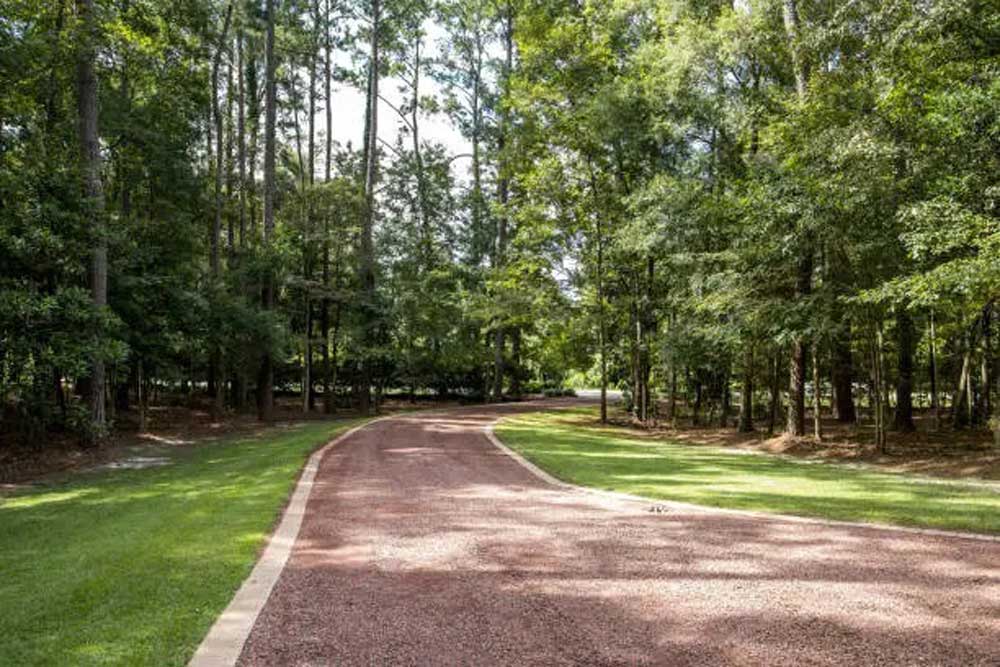Greetings everyone! Welcome to our driveway gravel guide.
Gravel driveways are the bee’s knees. They’re not just placing to the eyes, but also practical, sturdy, and budget-friendly. Once properly installed, they will stick around for a good long while.
Table of Contents
Types of gravel for driveway
Gravel is best categorized into two: Crushed stone and Naturally formed gravel. Crushed stone has rough, jagged edges, while naturally formed pebbles have a smoother finish.
Crushed Gravel
1. Crushed Stone/Gravel
Crushed stone is made up of pulverized rock such as limestone, trap rock, granite, or gneiss. The result? Gravel comprised of various-sized angular rocks with sharp edges. Crushed stone compacts well to form a stable driving surface.
Crushed stone is classified and graded according to the size of the screen used to sift the stone after crushing.
- #1 Grade: From 2 to 4 inches in size.
- #2 Grade: Falls between ½ to 3 inches.
- #3 Grade: ½ to 2-inched. Popular as a road base.
- #4 Grade: About 1 ½ inches or smaller.
- #8 Grade: 3/8 to ½ inches.
- #10 Grade: About 1/8 to ¼ inches or smaller.
- #57 Grade: It’s a mix of stones ranging from ½ to 1 inch, with an average size of ¾ inches. About half of them are smaller than ¾ inches, and the rest are bigger.
- #411 Grade: Similar to #57, but has stone dust to enhance compatibility.
Each region and quarry has its unique way of classifying its rocks but the grade mentioned holds true for most quarries and stone suppliers.
Crushed stone can also be classified as open or dense grade;
- Open grade also known as clean stone is crushed stone that has all fines sifted out. This makes it more permeable, allowing it to drain freely.
- Dense grade, quarry stone, quarry process, dirty stone, or crusher run, is a mix of small, 1 ½ inch crushed stone bits and stone dust. It’s great for compacting and works best as surface gravel on top of a well-drained base.
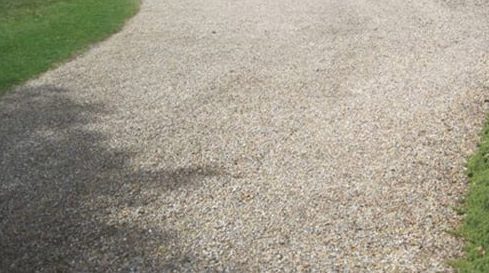
2. Crushed Asphalt
Crushed asphalt, recycled asphalt, or asphalt milling is a budget-friendly “driveway gravel“. It is a derivative of asphalt from past projects or roads that have been torn up and pulverized into gravel-sized bits.
It is sometimes sifted (screened) to get rid of dust and debris, leaving us with a clean gravel that packs down well to form a durable surface.
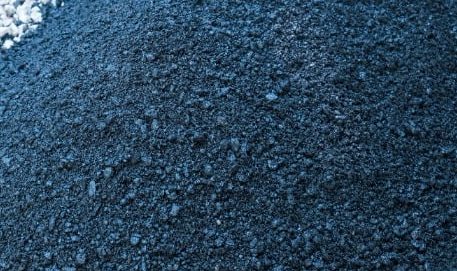
3. Crushed concrete
Crushed concrete is created by tearing up concrete, pulverizing it, and reducing it to small particles of crushed gravel and dry cement.
It is affordable, comparable in cost to crushed asphalt, or lower. Crushed concrete is either gray or white, is versatile, and can be mixed with other paving materials such as crushed asphalt.
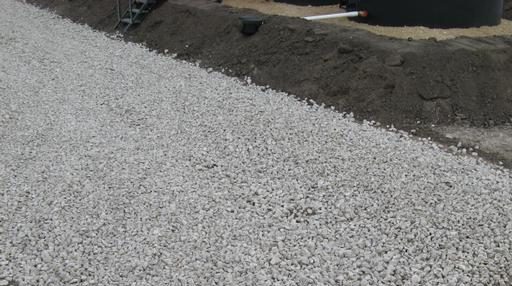
4. Steel Slag
Slag is a waste material formed when impurities are separated from molten steel in steel-making furnaces.
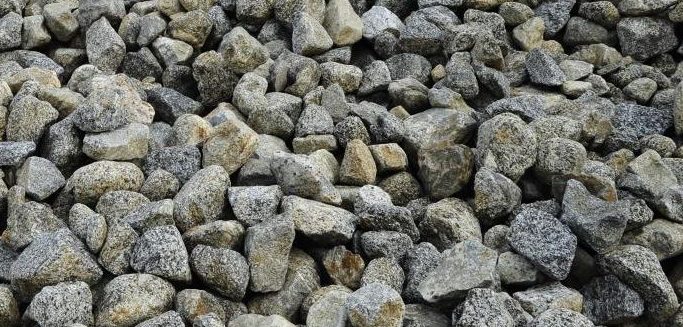
5. Alabama Path Stone
Ever heard of Alabama Path Stone? Alabama Path stone is made up of a blend of crushed Alabama rose stone and fines.
It’s quarried in the great state of Alabama, crushed, and run through screens to sort it out by size. This gravel can handle serious vehicle traffic.
It’s available in beige, light brown, and tan. The true colors come out when the material is spread and washed.
Naturally formed stone
6. Pea Gravel
Pea gravel is a type of small, round gravel with a smooth texture and is roughly the size of a pea, measuring around 3/8 inches in diameter. It comes in various colors such as brown, white, rust, and gray, and is often used as a decorative stone.
However, it requires a solid foundation, such as a crusher run, as a support base. Due to the round shape of the stones, they do not interlock and compact like crushed rock does, making them unsuitable for sloped driveways unless pea gravel glue is mixed in.
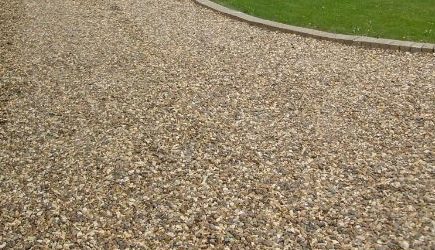
7. River rock/Rock Pebble
River rock or creek stone is available in shades such as brown, tan, and gray.
The stones have a smooth texture and range in size from 1 to 3 inches. They are naturally polished by the action of water and are typically quarried from creeks and river beds.
River rock is not suitable for sloping driveways.
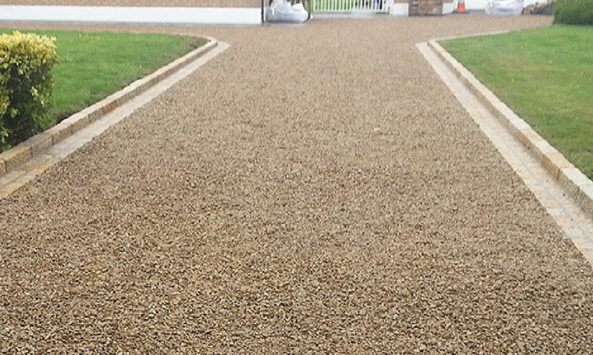
8. Caliche
Caliche, calcrete, hardpan, duricrust, or calcic soil is a sedimentary rock commonly found in arid or semi-arid regions including Arizona, California, Nevada, New Mexico, and Texas, where soil particles are cemented together by mineral precipitation and can be dug up and used as surfacing material.
It can be found in colors such as white, gray, brown, and reddish-brown.
Caliche is durable, cost-effective, and eco-friendly. However, it is not suitable for heavy rainfall areas, as it absorbs moisture and becomes soft, leading to rutting and erosion.
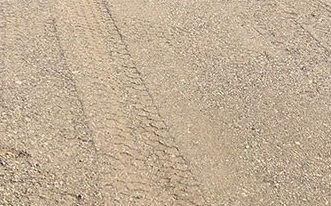
9. Marble chips
Marble chips are a type of decorative stone usually used for hardscaping projects. But they can also be used as a surfacing material for driveways and walkways.
However, marble chips can be quite slippery and tend to shift easily, and can be quite expensive.
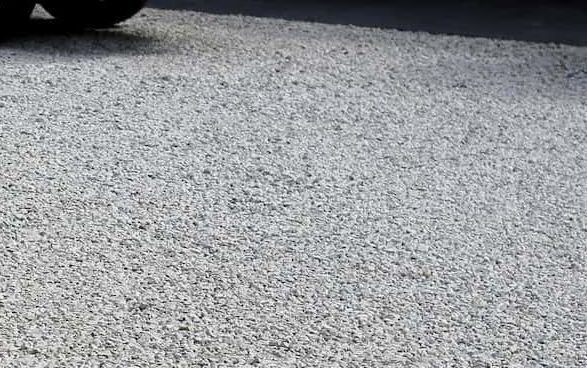
10. Crimson Stone
Crimson stone or red gravel, is a type of decorative aggregate available in a range of colors including red, burgundy, gray, black, and orange. It consists of a mixture of small to medium-sized angular stones.
Crimson stone is a popular driveway gravel, as it provides an attractive aesthetic to the property. It is often laid on a compacted gravel base and held in place with a binding agent to create a durable and long-lasting surface.
11. Decomposed Granite
Decomposed granite, or DG for short, is created by weathering and erosion of hard granitic rock. As the granite breaks down over time, it creates a fine-grained material that is quarried and used as a paving material.
It can be mixed with a stabilizing agent to create a durable and long-lasting surface that can withstand heavy vehicular traffic. However, well-placed and compacted loose DG can also handle vehicular traffic.
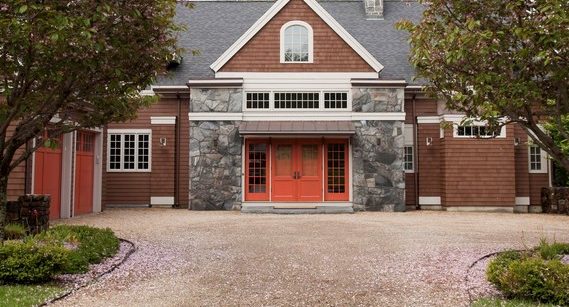
12. Lava Rock
Lava rocks are igneous rocks that form from ancient volcanic eruptions as lava cools and solidifies. They have a rough, porous texture, and are available in a range of sizes from pea-sized to larger boulders. Their porous nature allows water to filter through, making them excellent for retaining moisture.
Lava rocks typically come in rust-colored, brown, red, or black and are mined in states such as New Mexico, Utah, Colorado, and California. While they have a higher upfront cost, their long life and low maintenance make them a smart investment for landscaping projects. However, lava rock is not the best material for driveway surfaces. It is best used as a base layer for a well-blended surface gravel bed.
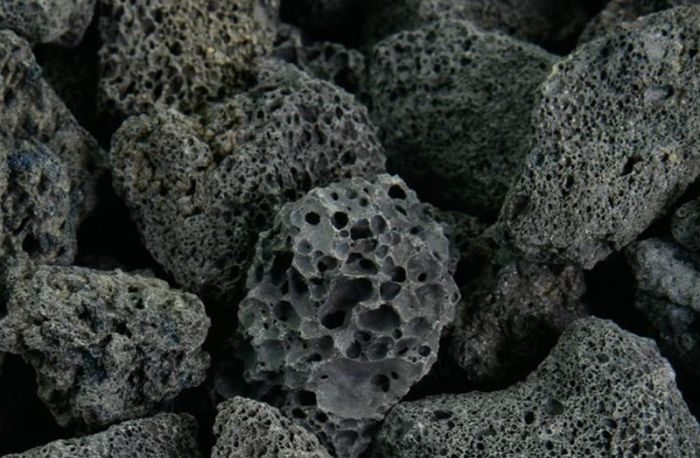
13. Jersey Shore gravel
Jersey Shore gravel, also known as trap rock or pea gravel, is a type of small, smooth gravel that resembles beach sand. It is available in various shades, including tan, white, brown, and gold.
This type of gravel is commonly used as a top layer for driveways in New England and Mid-Atlantic states. Due to its smooth texture, it requires edging to keep it in place.
Gravel Driveway Layers
Gravel driveways require proper installation and layering using a blend of various-sized stones. The foundation is built with larger stones while smaller-sized gravel is used for surfacing resulting in a durable driving surface.
Base Layer
The bottom layer of a gravel driveway is called the base layer. It provides structure and strength to the driveway as a solid footing.
The base layer typically consists of larger stones or gravel ranging from 1 to 2 inches in diameter (#3 or #4 in size), along with a small amount of clay and fine material.
Below the base layer is the subgrade layer, which is the soil underneath.
The surface layer
The topmost layer of a gravel driveway is typically composed of fines and smaller gravel stones which form a tightly bonded surface when compacted.
The driveway surfacing material is selected based on its functionality and aesthetic appeal. Options include #411 crushed stone, decomposed granite, asphalt millings, Jersey Stone, and marble chips.
Each layer, including the base layer consisting of larger stones, needs to be thoroughly compacted for a stable well driveway that lasts.
Selecting Driveway Gravel
Having the correct blend of stone, sand, and fines is crucial for a durable gravel driveway. It is best if the stones are crushed and broken.
The fines have a binding quality known as the plasticity index. Binding is often a function of the negatively charged clay particles. Quality driveway surfacing gravel should have a proper gradation of stones, sand, and fines. It requires more material passing through a #200 sieve.
The base gravel should be made up of larger rocks about 1 to ¾ inch on average in size.
Size of the gravel
The type of gravel selected depends on various factors such as budget, climate, and vehicular traffic. The size of the gravel is usually denoted as a number, with a smaller number indicating larger gravel sizes and vice versa.
The most commonly used sizes for driveways range from #3 to #9. For most projects, the popular options are #57 and crusher run. #57 is made up of clean gravel while the crusher run is a mixture of gravel, sand-sized, and fine particles, that compact quite well.

